|
|
Post by beagle on Feb 29, 2008 20:48:58 GMT 12
Were they brand new air frames when we got them and who did we sell them to.
|
|
|
|
Post by sniff on Feb 29, 2008 21:03:13 GMT 12
Pretty sure we were first to operate them, not sure where they went.
|
|
|
|
Post by corsair67 on Feb 29, 2008 21:14:40 GMT 12
Yeah, I think they were brand new when the RNZAF bought them.
From adf-serials.com:
NZ7940 421C1023 Delivered 12 February 1981 as N67961. To NZ7923 at hand-over to 42 Squadron on 28 February 1981. BOC 23 March 1981. Serial number changed to NZ7940 during 1981. Sold to Dennis Thompson International 03 April 1991 as ZK-FYX. Cancelled 23 April 1991. Ferried ex Auckland to United States on 16 April 1991. Registered as N678SW to Southern Wings Aircraft Sales, Bethany, Oklahoma on 23 April 1991. To Aviation Management Associates, Chino, California October 1993. To M. Meador, Cave Junction, Oregon July 1994. To M. Mullaley Inc. Monterey, California, 26 November 1996. Still flying as N678SW.
NZ7941 421C1024 Delivered 24 February 1981 as N6793X. To NZ7924 at hand-over to 42 Squadron. BOC 23 March 1981. Serial number changed to NZ7941 during 1981. Sold to Dennis Thompson International 03 April 1991 as ZK-FYY. Cancelled 23 April 1991. Ferried ex Auckland to United States on 16 April 1991. Registered as N432SW to Southern Wings Aircraft Sales, Bethany, Oklahoma on 23 April 1991. Exported to Germany 12 December 1991. To Global Air Service GmbH, Eggenfelden, Germany as D-IKST 17 December 1991. To J. Muehlbauer, Straubing, Germany July 1993. German registration cancelled 1998. Further details not known.
NZ7942 421C1025 Delivered 14 March 1981 as N67933. To NZ7925 at hand-over to 42 Squadron. BOC 01 April 1981. Serial number changed to NZ7942 during 1981. Sold to Dennis Thompson International 03 April 1991 as ZK-FYZ. Cancelled 23 April 1991. Ferried ex Auckland to United States on 16 April 1991. Registered as N942SW to Southern Wings Aircraft Sales, Bethany, Oklahoma on 23 April 1991. US registration cancelled March 1992 and registered to Global Air Service, Munich, Germany as D-IGRB on 12 March 1992. German registration cancelled 25 August 1993. To Aviation Management Associates, Chino, California as N942SW September 1993. To P and S Realty, Marshall, Texas August 1994. To Aviation Enterprises, Wilmington, Delaware 28 November 1997. To Davenport Co., Mount Vernon, Illinois 12 May 1998. To Allied Dairy Services, Kirkville, Missouri 06 July 1998. To Zanetis Oil Co., Hendricks, Indiana, 07 May 2001. Still flying as N942SW.
--------------------------------------------------------------------------------
|
|
|
|
Post by Peter Lewis on Dec 8, 2008 22:39:31 GMT 12
Does anyone know the real reason that these three aircraft were re-serialed from NZ7923/NZ7924/NZ7925 to NZ7940/NZ7941/NZ7942 some months after their arrival in 1981?
Both adfserials and kiwiaircraftimages gloss over this event.
|
|
|
|
Post by flyjoe180 on Dec 9, 2008 9:16:25 GMT 12
No idea, but as a random stab in the dark, the 40, 41 and 42 may have some relation to the numbers of the (then) transport squadrons?
|
|
|
|
Post by Peter Lewis on Dec 9, 2008 20:40:22 GMT 12
I suppose that's a possible explanation Joe, but I'd like something a bit more definite from someone involved at the time (Paul?). Most RNZAF re-serialling (which was not common) was the result of an extensive rebuild (eg Oxfords rebuilt as Consuls) or where there had been an inadvertent reuse of a serial previously issued (eg Beaver). In the case of the Cessnas, the early serials were certainly painted on the aircraft when they arrived in 1981, but seem to have been changed later that same year: NZ7923 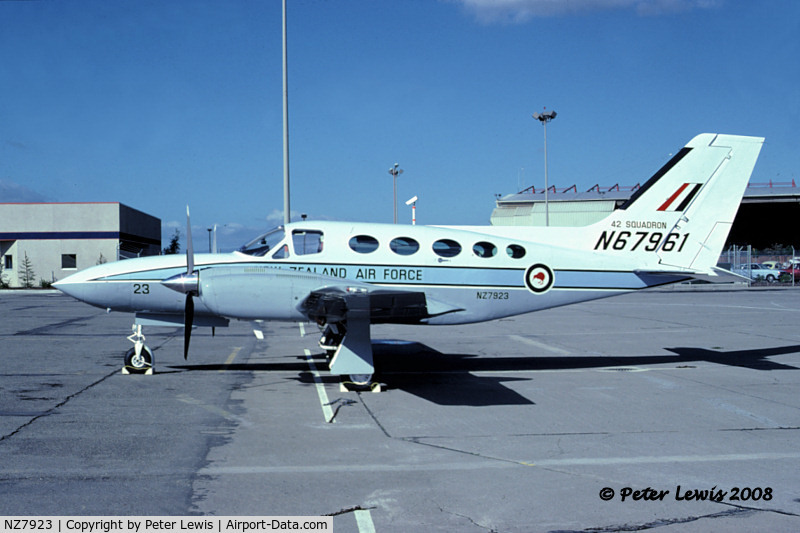 became NZ7940 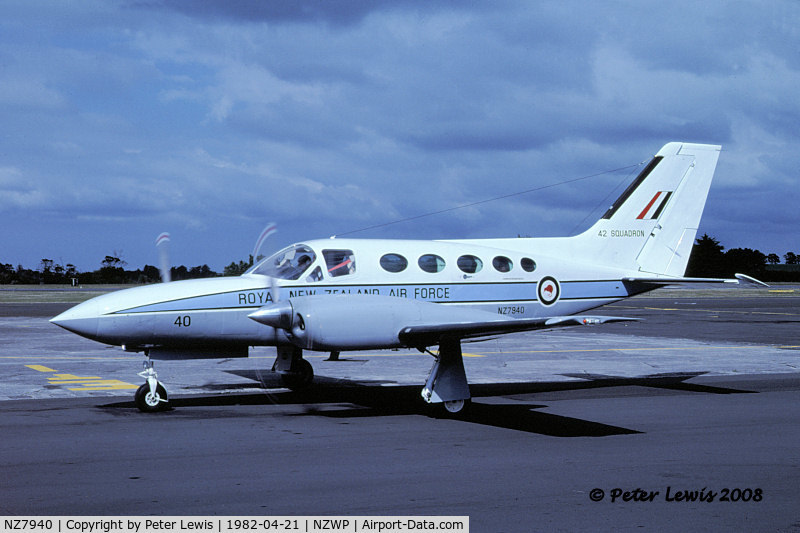 NZ7924 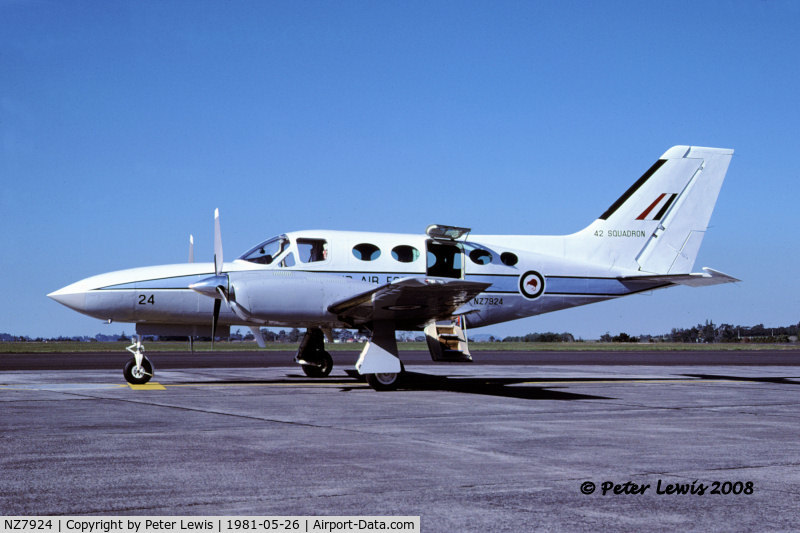 became NZ7941 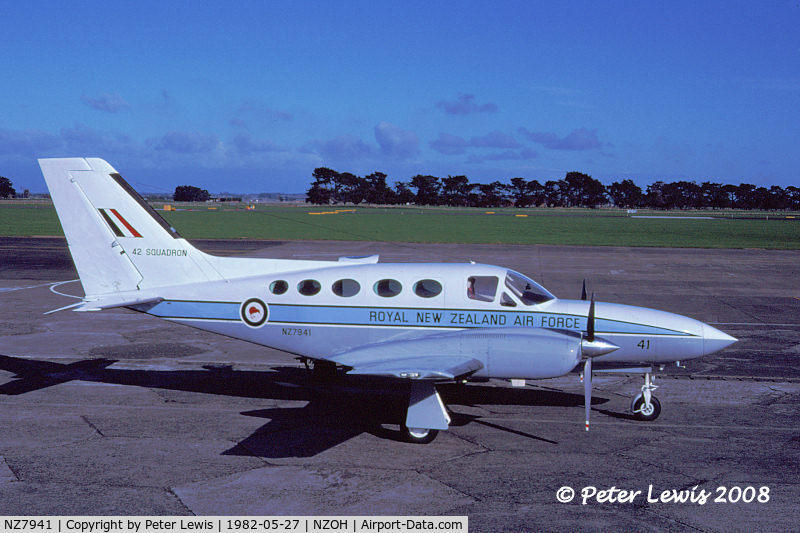 NZ7925 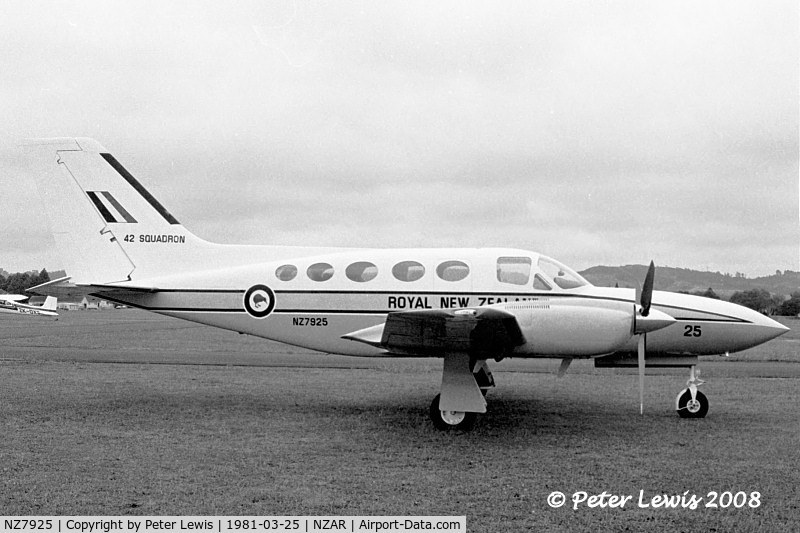 became NZ7942 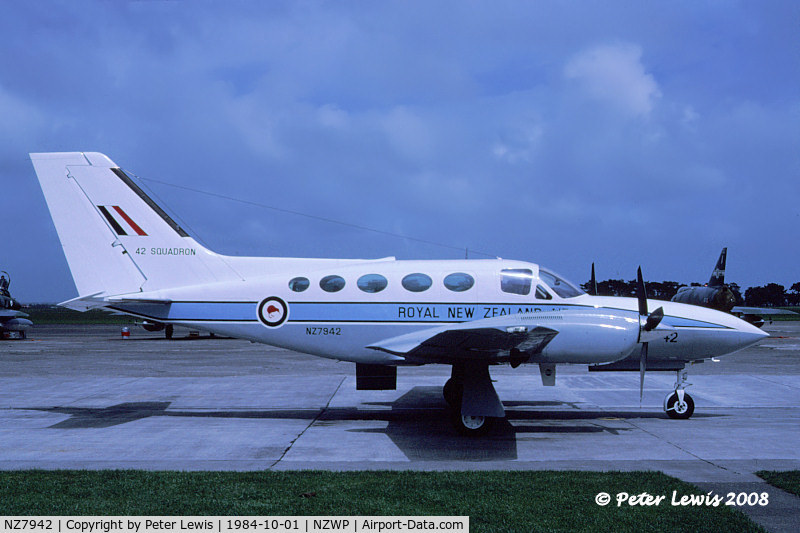 I guess somebody out there knows the answer! |
|
|
|
Post by Radialicious on Dec 9, 2008 21:02:38 GMT 12
I have a lot of good memories of the RNZAF C421's. I cut my teeth on them immediately after aircraft mechanic training until our disbandment in 1990. Often maligned for their reliability, they weren't suited to the short sectors that we tended to do especially when mistreated by pilots used to operating turbines.
|
|
|
|
Post by Dave Homewood on Dec 9, 2008 22:14:30 GMT 12
An interesting anomally with the serials, one I had not heard before.
I always thought the Golden Eagles looked fantastic.
|
|
|
|
Post by timmo on Dec 10, 2008 10:07:05 GMT 12
Im not even sure if this is possible with a/c serial number system, but just a thought: Perhaps past RNZAF aircraft had already used these serial numbers and were causing problems for some sort of past equipment register? (i.e. Serial numbers are unique at one point in time: there cannot be two NZ7923s flying at the same time, but are they totally unique temporally?) Could a NZ7923 exist in say a Harvard, de-registered after being scrapped/sold and then later used on a new aircraft later?...if that is the case then any IT/asset management system which uses that as the unique ID may run into problems if a complete history is kept)
Could well be very wide of the mark haha
|
|
|
|
Post by timmo on Dec 10, 2008 10:12:53 GMT 12
I do agree though- I always liked the Golden Eagle.....There were withdrawn from service before I ever saw one flying though
|
|
|
|
Post by tbf25o4 on Dec 10, 2008 10:21:48 GMT 12
The reason for the reserialling would have been to avoid confusion between the C421s
and the Andovers last two digits i.e Andover NZ7623 v's NZ7923 C421.
When we rewrote the serial policy in the mid 1980s this situation was incorporated in that the general guidelines were that there should be no overlapping of the last two digits for aircraft operating at the same base etc.
Didn't quite work out though as when the King Air's were repositioned from Whenuapai to Ohakea there was an overlap with the CT4Es!
Paul
|
|
|
|
Post by corsair67 on Dec 11, 2008 10:00:40 GMT 12
Interesting to hear why the serials were changed, and I guess it does make sense.
|
|
|
|
Post by Peter Lewis on Dec 12, 2008 9:58:43 GMT 12
Thanks for the clarification Paul. At least we now have a reasoning behind the change.
Not sure how that fits in with the Hercs and the Orions, both at Whenuapai and both in the sequence 01 - 05/06 but what the hell.
|
|
|
|
Post by camtech on Feb 11, 2009 12:10:52 GMT 12
Just looking at this issue again, and from my recollection, the paintshop were only given the block allocation (IE NZ79..) and used the last two of the manufacturers serial numbers (1023, 24 and 25) to complete the job. As Paul states, this conflicted with the policy and was corrected.
|
|
|
|
Post by horicle on Dec 22, 2018 12:03:45 GMT 12
What was wrong with the 'Golden Eagles'
I know of two factors relating to the turbocharged engines. One a minor irritant the other was expensive.
The minor one first. Please will some expert verify or correct this. Before shutting down such an engine it must be run for number of minutes at the correct rpm to allow the turbine to cool a bit. Now place yourself at a little airfield somewhere in NZ and a dignitary arrives in a little aircraft. It taxis up, parks, and while the reception committee waits for the big moment the engines drone on and on, much like this story, until finally all is quiet. Just a minor irritant but as always a major one at the time. I am sure I heard someone suggest starting the port engine shutdown routine as early as possible and taxiing in on one engine, but was it ever done?
Which leads to the major engine problem and pilot training. As far as I recall handling an engine failure involved instant shutdown in flight. This lead to many engine failures which was expensive, and at one stage we were using CAA's or Calflights spare engine to keep our Golden Eagles going.
With a full VIP load there would be two pilots and a Flight Steward. To prevent the aircraft becoming a 'tail sitter' during loading the pilots got in first and the Flight Steward positioned him/herself outside aft of the door where a shoulder or forearm could be surreptitiously used to balance the aircraft if the self loading cargo congregated in the door/rear seat area. True or not? I am sure I heard something like that a long time ago.
|
|
|
|
Post by Bruce on Dec 23, 2018 16:38:56 GMT 12
ahh, the Continental GTSIO-520 engines (Geared, Turbo-supercharged, Injected, 520 Cubic Inch...) Possibly one of the most complex piston engines available for GA Aircraft, and certainly a model that required very careful handling. "Gitsos" were definitely less reliable than the equivalent Lycoming TIO-540s used on Piper Chieftains etc. If the spec was for a close "like for like" replacement of the Devon, I wonder if the PA31 series was considered at the time? Obviously the budget at the time was for a piston twin, in which case the C421 and PA31 were new and state of the art. Short of going to a turbine such as the B200 or C406 whatever was chosen would have the turbine shutdown time issue and delicate C of G. Its interesting that several airlines operating turbocharged light twins found that on some routes (Cook strait, Auckland to Whangarei etc) elapsed time on the turbocharged piston twins was longer than that on a PBN Islander, which flew slower, but didnt have the run down time.
|
|
|
|
Post by baronbeeza on Dec 25, 2018 8:47:15 GMT 12
I was associated with 42 Sqdn back then and only have bar talk to go by. I understood the requirement was for turbo-prop twins so the Chieftain was never considered.
It was only when someone in Wellington (Political Branch) was researching the Conquest they discovered the Golden Eagle. Basically three of them came for the price of one.
It all went off the rails about then. Rumour was that even Cessna said the 421 was not the plane for the job.
I think the politicians of the day got a surprise when they discovered that a twin can't necessarily fly on one engine.
Denis Butler took a MP, I think Koro Wetere, for a ride off the runway end and through a fence at Wairoa.
They should have just bought the King Air back then.
|
|
|
|
Post by FlyingKiwi on Jan 7, 2019 11:18:45 GMT 12
Turbos and training don't go wonderfully hand in hand. Being in the (questionably fortunate?) position of conducting type ratings in a turbo piston twin, the sequence goes something like this:
Day 1 of course - Intro to type. Today we learn how to look after turbocharged engines so they don't require replacement every few hundred hours.
Day 2 of course - Intro to asymmetric handling. Today we disregard pretty much everything we learned yesterday.
However the more suitable a piston twin is as a transport aircraft, in most cases, the less suitable it is as a multi trainer. There are exceptions of course but that would require a bit of research on the part of those making the purchasing decision...
|
|
|
|
Post by Dave Homewood on Sept 1, 2024 9:29:39 GMT 12
I was just looking at the NZDF Serials page on the RNZAF's Cessna Golden Eagles, and I am a bit shocked to see that two of the three aircraft have been written off in crashes in recent years. Such a pity. It would be nice if the last existing example, NZ7942, could eventually end up in the Air Force Museum alongside the C-47 VIP transport aircraft.
|
|
|
|
Post by tbf2504 on Sept 1, 2024 10:15:16 GMT 12
The acquisition of the 421s had some political controversy at that time. The then Minister of Transport made the decision with some lobbying from the Ministry of Transport to assign VIP flying to the three F27s operated by CAL Flight, as it was considered they were more "presentable" that our ageing Dakotas. Following some push back from Defence and CAS in particular, it was agreed that the Air Force could have the 421s which could be used for air force internal communications, and when the F27 was not suited for a particular VIP task then they could be used for that. Another interesting fact of the 421s was that when 1RD was tasked with fitting our avionics systems to the airframes, the first one was sent to Woodbourne and measured up for the wiring looms through the fuselage, before looms were made for the three aircraft prior to fitment. However, when the second one was available, and flown to Woodbourne for a check, it was discovered that the fuselage frame lightening holds did match up with the first aircraft frame. Consequently, all three frames had individual wiring looms made. So much for production standards at Cessna!
|
|



